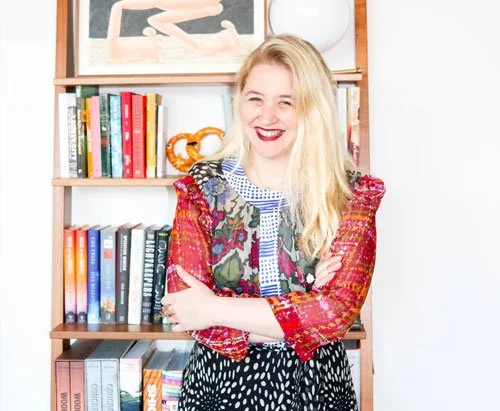ABOUT ZOE LUKOV
Zoe Lukov is a curator, producer and writer. Formerly chief curator of Faena Art in Miami Beach and in Buenos Aires, Lukov conceived of and produced both the first and second Faena Festivals in 2018 and 2019. In addition, she organized major solo exhibits by internationally recognized artists throughout the Faena Districts. She is a founding board member of Desert X, the non-profit site-specific exhibition based in California and recently produced a documentary about Desert X 2021 that made its premiere at the Getty Museum and broadcast on PBS.
She produces independent curatorial projects, among them the well-received Fair, an alternative, all-women, non-commercial art fair that took place in Miami at Brickell City Centre in 2017. She got her start in the art world working for Rashida Bumbray at The Kitchen in New York, Jeffrey Deitch at MOCA Los Angeles and Franklin Sirmans on Prospect 3, the New Orleans biennial. She is a Fulbright scholar and a graduate of Oberlin College.
Follow @zoelukov
ABOUT ABBY PUCKER
Abby is a cultural producer who is involved in initiatives sitting at the nexus of arts & culture, civic engagement, and technology. She is interested in leveraging the collective power and resources of this next generation of cultural influencers, artists and institutions to find more sustainable solutions to building a just and equitable creative economy. Most recently Abby produced Madison Wells' Chicago-based immersive art experience, Nevermore Park, based on Hebru Brantley's Flyboy. Her film credits include Emily Cohn’s “CRSHD,” which premiered at the 2019 Tribeca Film Festival and was released in virtual theaters May 2020, “When Jeff Tried to Save the World” starring Maya Erskine, and Erica Rose’s “Girl Talk” which premiered at Outfest in 2018. Additionally, she is a board member of The Marshall Project, Pioneer Works, Ghetto Film School,and the progressive American political organization, Run for Something.
Previous to her producing career, Abby worked in a business development capacity at Sotheby's NYC and ran Strategic Expansion at a workforce development centered tech company called Catalyte.
April 7 — 24, 2022
April 7: 12- 10 pm
April 8: 12- 6 pm
April 9: 12- 10 pm
April 10 — 14: 12 — 8pm
April 15 — 19: closed for holidays
April 20 — 24: 12 — 8pm
400 N. Peoria Street
Chicago
Skin in the Game is generously sponsored by Alec & Jennifer Litowitz and Shapack Partners.
The research and development of the concept, and the first iteration of Skin in the Game at Miami Art Week 2021, was supported by Palm Heights.
ABOUT
SKIN IN THE GAME
Skin in the Game is a collective offering, a coming out, a post-pandemic romp. It is about touch, risk, desire and skin—the potential, vulnerability and risk contained therein—as both a boundary to protect from danger, and a porous border to receive.
To consider skin is to consider the potential harm that might be done to it— there is an inherent violence, as well as the promise of pleasure, that comes with being in one’s skin.
How might we explore and understand our skin now– the site of potential transmission, of hand-sanitized stickiness, of lost contact. What can touch be now? The ecstasy and climax of it— la petite mort, the little death (of self?) and the potential union with the other.
To have “skin in the game” of course implies monetary investment, as well as political or social investment in a desired outcome—it underscores that one has something to lose. The phrase turns on the link between skin and currency— an economics of the physical—an understanding that the body is what we always place on the line.
We can buy and sell eroticism whether it be sex work, pornography, kink, or advertising, and our cultural narratives around skin are not easily extracted from their sexual currency.
It is impossible to disentangle currency and colorism—or ignore the way that racialized skin has both built capital and been manipulated for profit, Malcolm X wrote “...who in the world's history ever has played a worse ‘skin game’ than the white man?”
‘Game,’ whether that be in terms of sport and athleticism, or the hunt for wild game bleed through into the language—a framework to explore the eroticizing and exoticizing of bodies that we consume visually. In our pursuit of ‘game’ we find the vestiges of our own bestiality, alongside a yearning to transcend the limitation of our very bodies. Animal skins, hunting and the sexual proclivities of ‘furries’ are offered perhaps a glimpse at interspecies transgression—towards a trans-human future.
Tattooing, scarification and the mortification of the flesh underscore both the sanctity and profanity of the body. Our most precious idols, biblical scenes, and illustrations of religious piety are often quite close to an iconography of BDSM. Torture and pain such close bedmates with spiritual awe, awakening and transcendence.
Skin in the Game is about power, danger, currency, play, joy, indulgence... as well as the taboo, the voyeuristic, the hedonistic, the violating and the pleasurable.
Artists included here explore the edges of the erotic. Their works mark the margins of a hungering. Their ‘edging’ implies the sought-after climax that doesn’t necessarily arrive... they point towards our most intimate and yet never name it. The artworks on view are an offering to exfoliate the exoskeletons of our collective desire. These are notes on transmission; as well as the barriers— and possibilities—of our skin. There are no answers here but rather a series of questions about where we might find connections and entry points to understand the skin we live in, skins that shed and are scarred, skins that shiver in pain, in pleasure.
Poet and novelist Ocean Vuong writes “Is that what art is? To be touched thinking what we feel is ours when, in the end, it was someone else, in longing who finds us?” These works of art transmit feeling, they offer us porousness so that we might reach out and feel (with) each other in unadulterated and perhaps ecstatic touch.
— Zoe Lukov, curator


